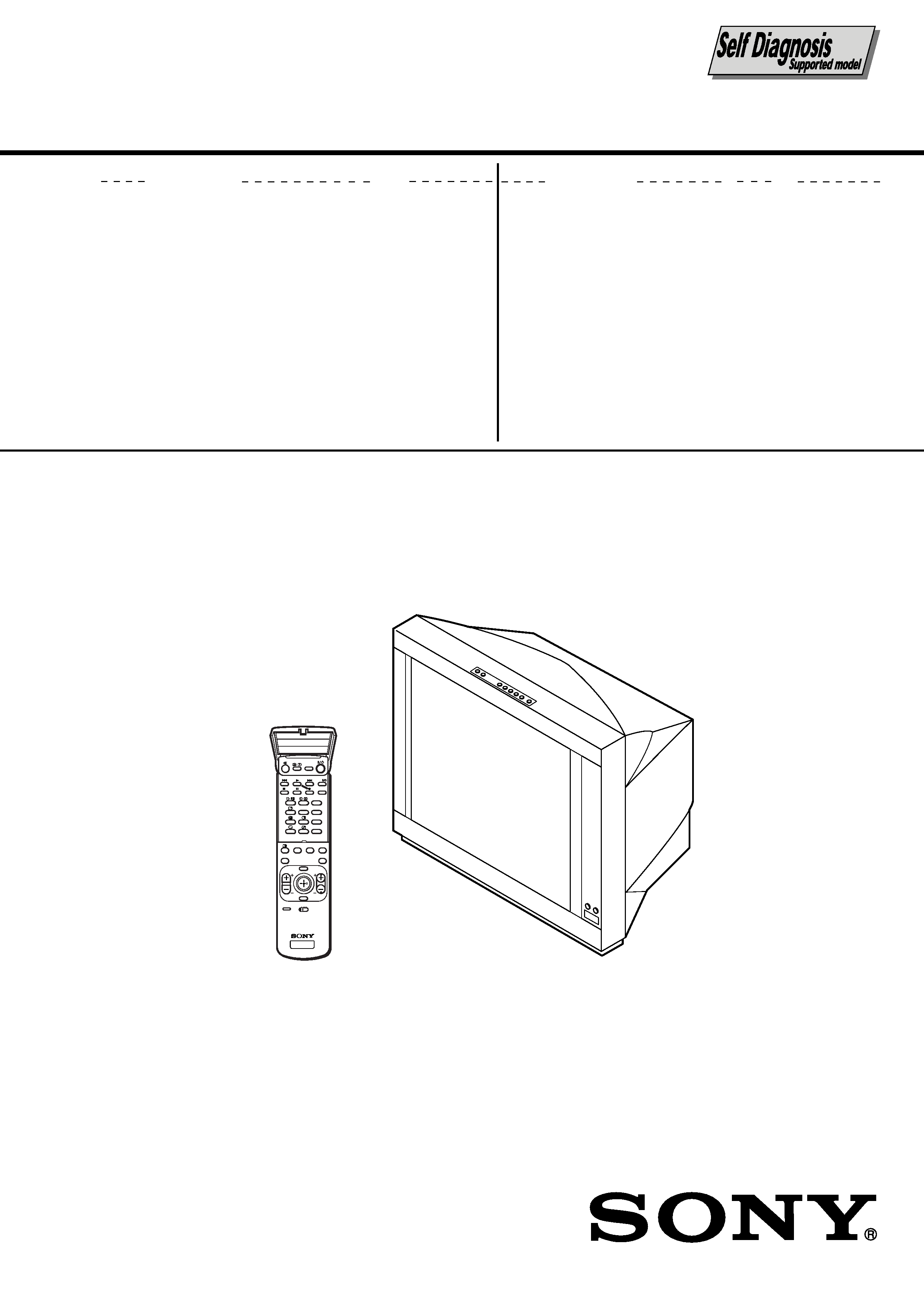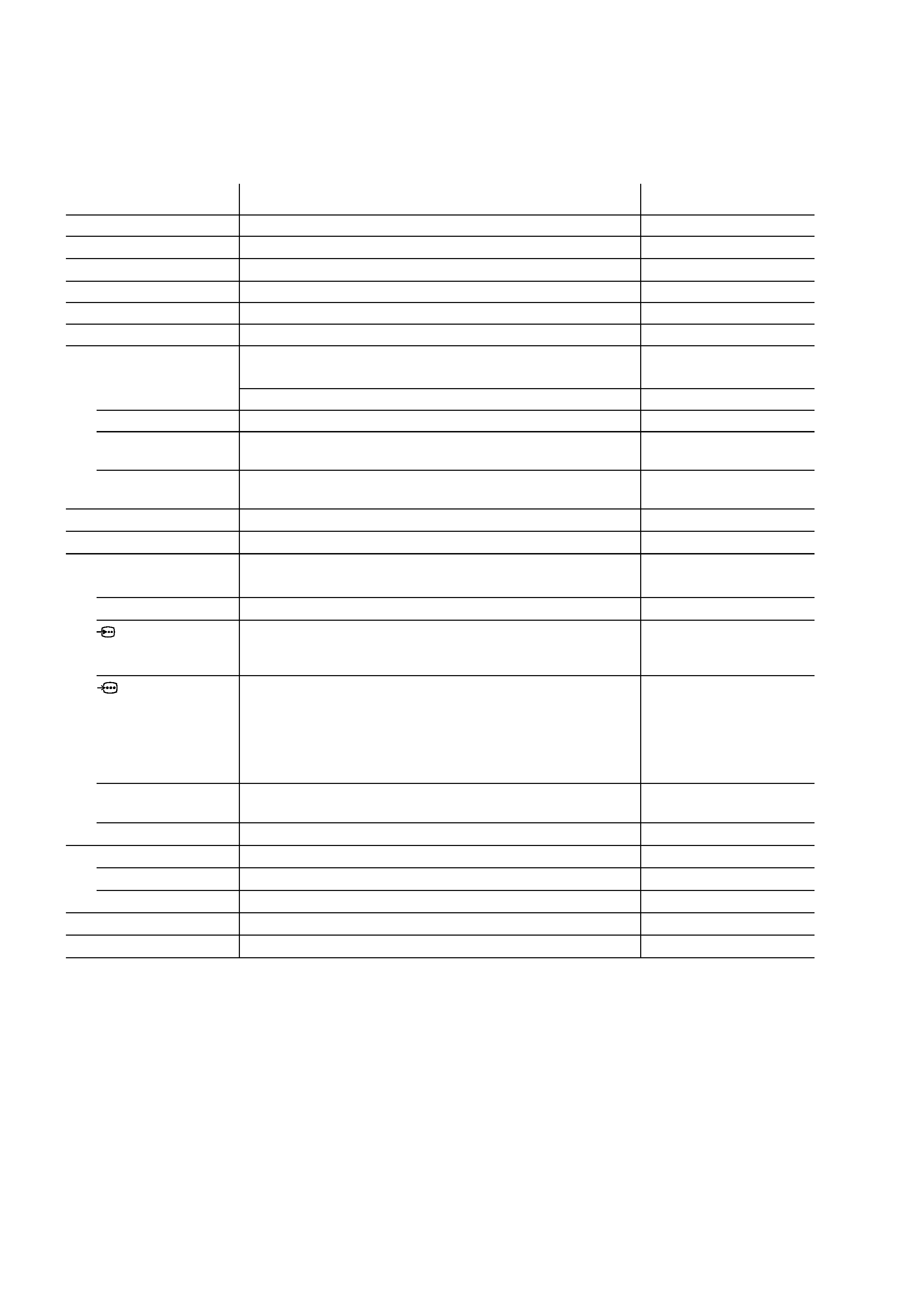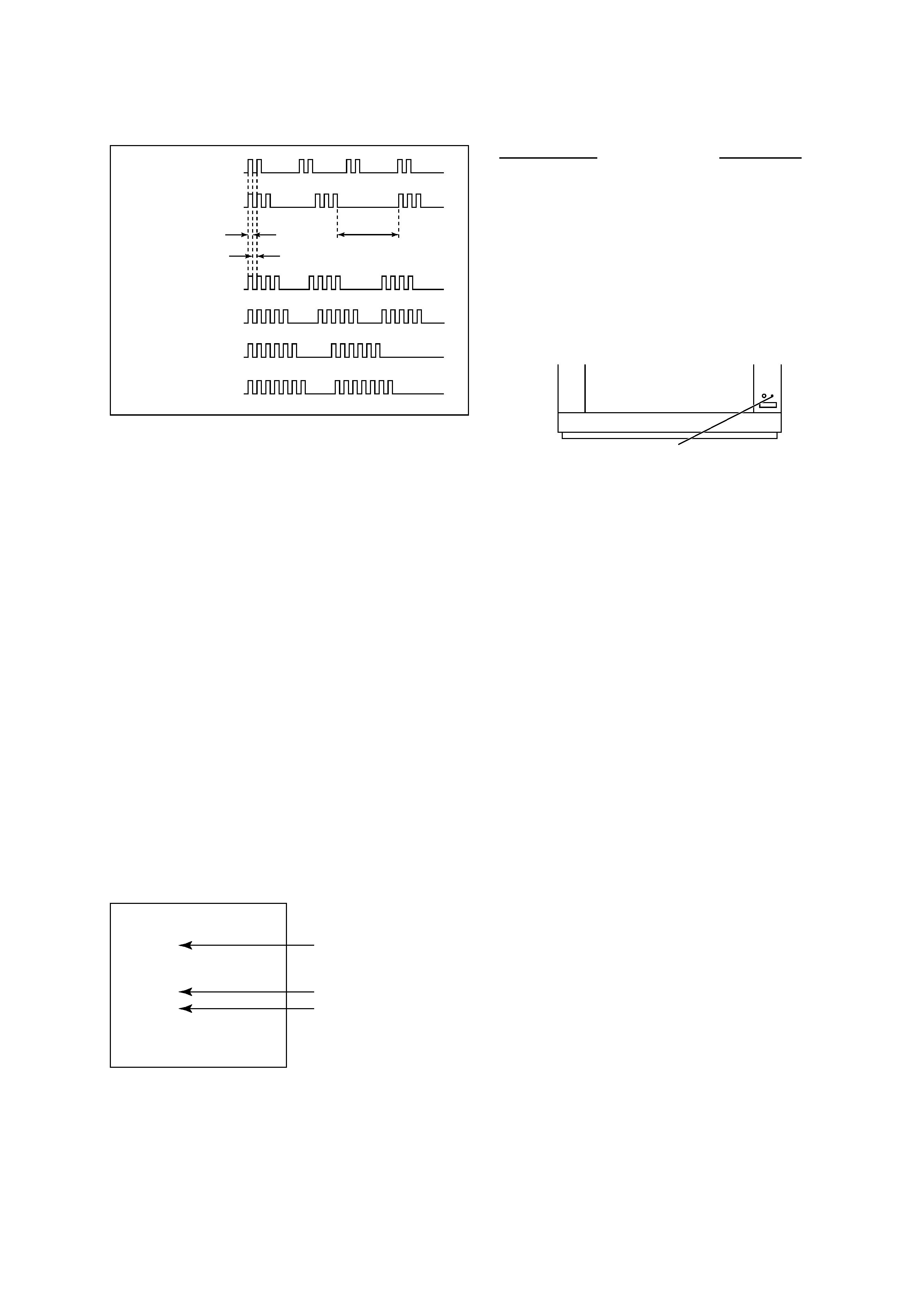
MODEL
COMMANDER
DEST.
CHASSIS NO.
CHASSIS
TRINITRON ® COLOR TV
SERVICE MANUAL
AG3
MODEL
COMMANDER DEST.
CHASSIS NO.
KV-ES38M31 RM-916 Australia
SCC-P72A-A
KV-ES38M61 RM-916 GE
SCC-P35B-A
KV-ES38M90 RM-916 Hong Kong SCC-P27C-A
KV-ES38M91 RM-916 ME
SCC-P32F-A
TV
TITLE
PROGR +
PROGR
PROGR
.
MENU
ENTER
DRC-MF
FAVORITE
PROGR
INDEX
PIC
MODE
SOUND
MODE
SURROUND
PRESET
VTR 1 2 3 DVD
VIDEO

2
KV-ES38M31/ES38M61/ES38M90/ES38M91
RM-916
SPECIFICATIONS
Note
Power requirements
220-240 V AC, 50/60 Hz
Power consumption (W) Indicated on the rear of the TV
Television system
B/G, I, D/K, M
Color system
PAL, PAL 60, SECAM, NTSC4.43, NTSC3.58
Stereo/Bilingual system
NICAM Stereo/Bilingual B/G, I, DK; A2 Stereo/Bilingual B/G
Teletext language
English, Arabic, French
KV-ES38M90 only
Channel coverage
B/G
VHF: E2 to E12 / UHF: E21 to E69 / CATV: S01 to S03, S1 to S41
VHF: 0 to 12, 5A, 9A / UHF: 28 to 69 / CATV: S01 to S03, S1 to S41 Australia only
I
UHF: B21 to B68 / CATV: S01 to S03, S1 to S41
D/K
VHF: C1 to C12, R1 to R12 / UHF: C13 to C57, R21 to R60
CATV: S01 to S03, S1 to S41, Z1 to Z39
M
VHF: A2 to A13 / UHF: A14 to A79 /
CATV: A-8 to A-2, A to W+4, W+6 to W+84
(Antenna)
75-ohm external terminal
Audio output (Speaker)
15W + 15W
Number of terminal
D (Video)
Input: 4*
Output: 1
Phono jacks; 1 VP-P, 75 ohms
(Audio)
Input: 4*
Output: 1
Phono jacks; 500 mVrms
(S Video)
Input: 2
Y : 1 Vp-p, 75 ohms,
unbalanced, sync negative
C : 0.286 Vp-p, 75 ohms
(Component Video) Input: 1
Phono jacks
Y : 1 Vp-p, 75 ohms,
sync negative
CB : 0.7 Vp-p, 75 ohms
CR : 0.7 Vp-p, 75 ohms
Audio : 500 mVrms
DIGITAL IN
Input: 1
Phone jack;
0.5 Vp-p, 75 ohms
2
(Headphones)
Output: 1
Stereo minijack
Picture tube
38 inch
Tube size (cm)
97
Measured diagonally
Screen size (cm)
91
Measured diagonally
Dimension (w/h/d, mm)
962 x 728 x 615
Mass (kg)
112
Design and specifications are subject to change without notice.
SAFETY-RELATED COMPONENT WARNING!!
COMPONENTS IDENTIFIED BY SHADING AND MARK
! ON
THE SCHEMATIC DIAGRAMS, EXPLODED VIEWS AND IN
THE PARTS LIST ARE CRITICAL TO SAFE OPERATION.
REPLACE THESE COMPONENTS WITH SONY PARTS
WHOSE PART NUMBERS APPEAR AS SHOWN IN THIS
MANUAL OR IN SUPPLEMENTS PUBLISHED BY SONY.
CAUTION
SHORT CIRCUIT THE ANODE OF THE PICTURE TUBE AND
THE ANODE CAP TO THE METAL CHASSIS, CRT SHIELD,
OR CARBON PAINTED ON THE CRT, AFTER REMOVING THE
ANODE.

3
KV-ES38M31/ES38M61/ES38M90/ES38M91
RM-916
TABLE OF CONTENTS
Section
Title
Page
Section
Title
Page
SELF DIAGNOSTIC FUNCTION ........................... 4
1. GENERAL ........................................................ 7
2. DISASSEMBLY
2-1. Rear Cover Removal .............................................. 33
2-2. Speaker Box Removal ........................................... 33
2-3. H2 Board Removal ................................................ 33
2-4. Chassis Assy Removal ........................................... 34
2-5. Service Position ..................................................... 34
2-6. DH Board Removal ............................................... 34
2-7. J Board Removal .................................................... 34
2-8. B3, D1 and E Boards Removal ............................. 35
2-9. A and D Boards Removal ...................................... 35
2-10. H1 Boards Removal ............................................... 35
2-11. F2 Board Removal ................................................. 35
2-12. Demagnetization Coil Removal ............................ 36
2-13. Top Switch Removal
(H3 Board Removal) .............................................. 36
2-14. G2 Lead Removal .................................................. 36
2-15. Picture Tube Removal ........................................... 37
2-16. Frame Sub-Assy Disassembly ............................... 37
3. SERVICE JIG
3-1. Jigs Required for Servicing ................................... 40
4. CIRCUIT BOARDS LOCATION ..................... 40
5. SET-UP ADJUSTMENTS
5-1. Beam Landing ........................................................ 41
5-2. Convergence Adjustment ....................................... 42
5-3. Focus Adjustment .................................................. 44
5-4. Neck Assy Twist Adjustment ................................ 44
5-5. G2 (Screen) and White Balance Adjustment ........ 45
6. CIRCUIT ADJUSTMENTS
6-1. Adjustment with Commander ............................... 46
6-2. Asjustment Method ............................................... 46
6-3. Picture Quality Adjustment ................................... 59
6-4. Deflection Adjustment ........................................... 60
6-5. A Board Ajustment After IC003 (Memory)
Replacement .......................................................... 62
6-6. Picture Distortion Adjustment ............................... 63
7. DIAGRAMS
7-1. Block Diagram ....................................................... 65
7-2. Schematic Diagram ................................................ 70
(1) Schematic Diagram of A Board ....................... 77
(2) Schematic Diagram of D Board ...................... 78
(3) Schematic Diagram of D1 Board .................... 79
(4) Schematic Diagram of C Board ....................... 80
(5) Schematic Diagram of E Board ....................... 81
(6) Schematic Diagram of J Board ........................ 82
(7) Schematic Diagrams of VM and F1 Boards .... 83
(8) Schematic Diagrams of H1, H3, F2 and
SP Boards ......................................................... 84
(9) Schematic Diagrams of DH and H2 Boards ... 85
(10) Schematic Diagram of A1 Board ................... 86
(11) Schematic Diagram of BC4 Board ................ 97
(12) Schematic Diagram of V Board ..................... 98
(13) Schematic Diagram of B3 Board ................... 99
7-3. Voltage Measurement .......................................... 114
7-4. Waveforms ........................................................... 127
7-5. Printed Wiring Board and Parts Location ........... 131
7-6. Semiconductors ................................................... 147
8. EXPLODED VIEWS
8-1. Speaker Bracket ................................................... 150
8-2. Chassis ................................................................. 151
8-3. Picture Tube ......................................................... 152
9. ELECTRICAL PARTS LIST ......................... 153

4
KV-ES38M31/ES38M61/ES38M90/ES38M91
RM-916
SELF DIAGNOSTIC FUNCTION
The units in this manual contain a self-diagnostic function. If an error occurs, the STANDBY/TIMER lamp will automati-
cally begin to flash.
The number of times the lamp flashes translates to a probable source of the problem. A definition of the STANDBY/
TIMER lamp flash indicators is listed in the instruction manual for the user's knowledge and reference. If an error symp-
tom cannot be reproduced, the remote commander can be used to review the failure occurrence data stored in memory
to reveal past problems and how often these problems occur.
1.
DIAGNOSTIC TEST INDICATORS
When an errors occurs, the STANDBY/TIMER lamp will flash a set number of times to indicate the possible cause of the
problem. If there is more than one error, the lamp will identify the first of the problem areas.
Result for all of the following diagnostic items are displayed on screen. No error has occured if the screen displays a "0".
Diagnostic
Item
Description
· Power does not
turn on
· +B overcurrent
(OCP)
· +B overvoltage
(OVP)
· Vertical
deflection failure
· White balance
failure (no
PICTURE)
· Horizontal
deflection
failure
· Audio Protection
· Micro reset
No. of times
STANDBY/TIMER
lamp flashes
Does not light
2 times
3 times
4 times
5 times
6 times
7 times
--
Self-diagnostic
display/
Diagnostic result
--
002:000 or
002:001~255
003:000 or
003:001~255
004:000 or
004:001~255
005:000 or
005:001~255
006:000 or
006:001~225
007:000 or
007:001~225
101:00 or
101:001~225
Probable
Cause
Location
· Power cord is not plugged
in.
· Fuse is burned out F1601
(F1 Board)
· H.OUT Q6807 is shorted.
· H.LIM Q6810 is shorted.
· PH 6602 faulty.
· 10.5V is not supplied.
(D board)
· V.OUT IC6800 faulty
D6816 faulty
D6817 faulty
D6824 faulty
R6852 open
R6851 open
· G2 is improperly adjusted.
(Note 2)
· CRT problem.
· Video OUT IC9001, 9002,
9003 are faulty. (C board)
· IC8306 (J board) and
IC4301 (E board) are faulty.
· No connection E board to C
board.
· C6831 is open circuit.
· CN6101 (D1 board) is
disconnected.
· Power supply fails.
· IC1203, IC1204 faulty
· Discharge CRT (C Board)
· Static discharge
· External noise
Detected
Symptoms
· Power does not come on.
· No power is supplied to the
TV.
· AC power supply is faulty.
· Power does not come on.
· Load on power line is
shorted.
· Power does not come on.
· Vertical deflection pulse is
stopped.
· Vertical size is too small.
· Vertical deflection stopped.
· No raster is generated.
· CRT cathode current
detection reference pulse
output is small.
· H pulse output is too high.
· There is picture but speaker
does not release sound.
· Power is shut down shortly,
after this return back to
normal.
· Detect Micro latch up.
Note 1: Refer to screen (G2) Adjustment in section 4-5 of this manual.

5
KV-ES38M31/ES38M61/ES38M90/ES38M91
RM-916
2. DISPLAY OF STANDBY/TIMER LIGHT FLASH COUNT
Lamp ON 0.3 sec.
Lamp OFF 3 sec.
Lamp OFF 0.3 sec.
2 times
3 times
4 times
5 times
6 times
7 times
3. STOPPING THE STANDBY/TIMER FLASH
Turn off the power switch on the TV main unit or unplug the power cord from the outlet to stop the STANDBY/TIMER
lamp from flashing.
4. SELF-DIAGNOSTIC SCREEN DISPLAY
For errors with symptoms such as "power sometimes shuts off" or "screen sometimes goes out" that cannot be con-
firmed, it is possible to bring up past occurances of failure for confirmation on the screen:
[To Bring Up Screen Test]
In standby mode, press buttons on the remote commander sequentially in rapid succession as shown below:
[Screen display] / channel [5] / Sound volume [-] / Power ON
Note that this differs from entering the service mode (mode volume [+]).
Self-Diagnosis screen display
STANDBY/SLEEP lamp
Diagnostic Item
Flash Count*
+B overcurrent
2 times
+B overvoltage
3 times
V deflection stop
4 times
White balance failure
5 times
High voltage protector
6 times
Audio Protection
7 times
* One flash count is not used for self-diagnostic.
002 : 000
003 : 000
004 : 000
005 : 001
Numeral "0" means that no fault has been detected.
Numeral "1" means a fault has been detected.
006 : 002
007 : 000
101 : 000
SELF DIAGNOSTIC
Numeral "2" means two faults have been detected.
